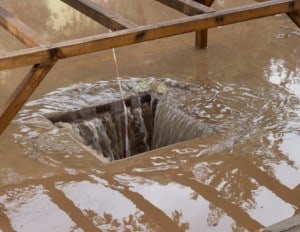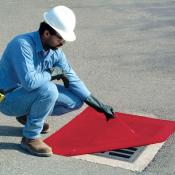How your business can keep waterways pollutant-free this spring
 As the winter doldrums begin to recede, spring marks a fresh start with its transition to better weather and new growth. But unfortunately, the change of season isn’t all about flowers and sunshine.
As the winter doldrums begin to recede, spring marks a fresh start with its transition to better weather and new growth. But unfortunately, the change of season isn’t all about flowers and sunshine.
Spring also signals the onset of stormwater runoff—a potentially damaging consequence of melting snow and increased precipitation. It’s important for businesses to manage stormwater effectively to protect both their facilities and the environment. Read on to explore some useful pollution-preventing products you can equip your business with.
Understanding Stormwater Runoff
Stormwater runoff occurs when rainwater or melted snow flows over surfaces, picking up pollutants such as oil, grease, chemicals, and debris along the way. This contaminated water can then enter waterways, posing threats to aquatic life and water quality.
From a facility’s perspective, rising water from snowmelt or rain can sometimes result in floor damage. Water buildup in poorly drained areas can also compromise the structural integrity of a building. Even if you live in an area that doesn’t see much snow, increased precipitation can cause similar unwanted effects if not handled properly.
Although tools such as spill containment berm dikes can divert liquids to more favorable paths and help prevent runoff damage, storm water can still pose a risk to the environment. Known as “urban runoff,” water that comes into contact with pollutants from urban and suburban areas can pick up hazardous chemicals and become contaminated. If this water makes its way back to streams, lakes, or other bodies of water, it can harm wildlife, vegetation, and even foul drinking water. And that’s a big deal when it comes to Environmental Protection Agency (EPA) regulations.
Reduce your facility’s environmental impact
Taking action to decrease your facility’s environmental impact is incredibly important, and doesn’t have to be hard. There are several precautions you can take to prevent stormwater runoff water pollution and damage to your facility.
- A lightweight drain cover seal can be quickly placed over floor drains not only for spills, but to prevent potentially hazardous runoff from reaching the drain. For the best result, the seal should be at least six inches larger than the drain it’s affixed to.
- Similarly, a floor drain plug blocks smaller circular drains before a spill can occur. Used as a proactive spill prevention method, these plugs are easy to remove when water needs to be drained.
- In extreme instances in which storm water must pass through a drain, prevent sediment and other pollutants from entering water systems by using a storm drain filter insert. This simple drain guard effectively traps oil, grease, litter, and other contaminants as water passes through.
Additional stormwater runoff remediation techniques
If oil does manage to spill into a storm drain or basin, you can reduce its negative effects with a passive oil skimmer. Float this absorbent polymer matrix on the surface of polluted water, and remove up to two gallons of oil at a time.
Alternatively, you can deploy a specialty oil-absorbent for marine applications such as a bilge boom, sock and net bag. If you’re seeking an all-natural solution, Archaea is a bioremediation product with oil-degrading microorganisms. It comes in powder, packet, and tablet forms that are ideal for a variety of drain or water clean up applications.
For pump-outs or drainage operations at construction sites and other commercial industries, consider pipe socks or trench drain filters. These geotextile filters attach to the end of pipes or lay alongside drains to trap sediment and hydrocarbons from water flow.
Taking Action
As we begin to see increased runoff, ensure your business is doing its part to create a healthy environment. By implementing stormwater runoff management solutions and best practices, your facility can significantly reduce its environmental footprint and contribute to cleaner waterways.
For assistance in selecting the right stormwater management products, AbsorbentsOnline is here to help. Feel free to contact us by email or call toll free at (800) 869-9633.
This is a revision to a blog post with an original publication date of April 22, 2015.
